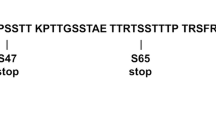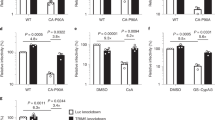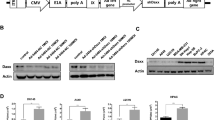Abstract
Targeting of adenovirus (Ad)-encoded therapeutic genes to specific cell types has become a major goal in gene therapy. Redirecting the specificity of infection requires the abrogation of the natural interaction between the viral fiber and its cellular receptors (CAR) and the simultaneous introduction of a new binding specificity into the viral capsid. To abrogate the natural affinity of the fiber, we have mutated residues presumed to be directly or indirectly involved in CAR-binding in the knob domain of the fiber protein. These residues are located in the AB loop (Ser408) and in the DG loop (Tyr491, Ala494, Ala503). The mutations Ser408Glu, Tyr491Asp, Ala494Asp and Ala503Asp did not prevent the incorporation of trimeric fibers in the viral capsid but led to loss of CAR binding in vitro. Infectivity of the mutant viruses could be restored in vitro by introducing a ligand at the C-terminal end of the knob, confirming that the reduced infectivity of the fiber-modified virus was due to an impaired interaction of the viral particle with the CAR receptor. However, after systemic delivery, the in vivo biodistribution of impaired CAR-binding viruses without addition of a specific ligand was not altered when compared with wild-type Ad.
This is a preview of subscription content, access via your institution
Access options
Subscribe to this journal
Receive 12 print issues and online access
$259.00 per year
only $21.58 per issue
Buy this article
- Purchase on Springer Link
- Instant access to full article PDF
Prices may be subject to local taxes which are calculated during checkout






Similar content being viewed by others
References
Bramson J, Graham F, Gauldie J . The use of adenoviral vector for gene therapy and gene transfer in vivo Curr Opin Biotech 1995 6: 590–595
Crystal R . Transfer of genes to humans: early lessons and obstacles to success Science 1995 270: 404–410
Goodman J et al. Adenoviral-mediated thymidine kinase gene transfer into the primate brain followed by systemic ganciclovir: pathologic, radiologic and molecular studies Hum Gene Ther 1996 7: 1241–1250
Yee D et al. Adenovirus-mediated transfer of herpes simplex virus thymidine kinase in an ascites model of human breast cancer Hum Gene Ther 1996 7: 1251–1257
Bui L et al. In vivo therapy of hepatocellular carcinoma with a tumor-specific adenoviral vector expressing interleukin-2 Hum Gene Ther 1997 8: 2173–2182
Bergelson J et al. Isolation of a common receptor for coxsackie B viruses and adenoviruses 2 and 5 Science 1997 275: 1320–1323
Tomko R, Xu R, Philipson L . HCAR and MCAR: the human and mouse cellular receptors for subgroup C adenoviruses and group B coxsackieviruses Proc Natl Acad Sci USA 1997 94: 3352–3356
Hong S et al. Adenovirus type 5 fiber knob binds to MHC class I α2 domain at the surface of human epithelial and B lymphoblastoid cells EMBO J 1997 16: 2294–2306
Davison E, Kirby T, Elliot T, Santis G . The human HLA-A0201 allele, when expressed in hamster cells, is not a high-affinity receptor for adenovirus type 5 fiber J Virol 1999 73: 4513–4517
McDonald D et al. Coxsackie and adenovirus receptor (CAR)-dependent and major histocompatibility complex (MHC) class I-independent uptake of recombinant denoviruses into human tumour cells Gene Therapy 1999 6: 1512–1519
Mathias P, Wickham T, Moore M, Nemerow G . Multiple adenovirus serotypes use αv integrins for infection J Virol 1994 68: 6811–6814
Wickham T, Mathias P, Cheresch D, Nemerow G . Integrins αvβ3 and αvβ5 promote adenovirus internalization but not virus attachment Cell 1993 73: 309–319
Henry L et al. Characterization of the knob domain of the adenovirus type 5 fiber protein expressed in E. coli J Virol 1994 68: 5239–5246
Louis N et al. Cell binding domain of adenovirus serotype 2 fiber J Virol 1994 68: 4104–4106
Xia D, Henry L, Gerard R, Deisenhofer J . Crystal structure of the receptor-binding domain of adenovirus type 5 fiber protein at 1.7A resolution Structure 1994 2: 1259–1270
van Raaij M, Mitraki A, Lavigne G, Cusack S . A triple β-spiral in the adenovirus fibre shaft reveals a new structural motif for a fibrous protein Nature 1999 401: 935–938
van Raaij M, Louis N, Chroboczek J, Cusack S . Structure of the human adenovirus serotype 2 fiber head domain at 1.5A resolution Virology 1999 262: 333–343
Roelvink P et al. Identification of a conserved receptor-binding site on the fiber proteins of CAR-recognizing adenoviridae Science 1999 286: 1568–1571
Bewley M et al. Structural analysis of the mechanism of adenovirus binding to its human cellular receptor, CAR Science 1999 286: 1579–1583
Kirby I et al. Mutations in the DG loop of adenovirus type 5 fiber knob protein abolish high-affinity binding to its cellular receptor CAR J Virol 1999 73: 9508–9514
Kirby I et al. Identification of contact residues and definition of the CAR-binding site of adenovirus type 5 fiber protein J Virol 2000 74: 2804–2813
Santis G et al. Molecular determinants of adenovirus serotype 5 fibre binding to its cellular receptor CAR J Gen Virol 1999 80: 1519–1527
Defer C, Belin M, Caillet-Boudin M, Boulanger P . Human adenovirus-host cell interactions: comparative study with members of subgroups B and C J Virol 1990 64: 3661–3673
Stevenson S et al. Human adenovirus serotypes 3 and 5 bind to two different cellular receptors via the fiber head domain J Virol 1995 69: 2850–2857
Chartier C et al. Efficient generation of recombinant adenovirus vectors by homologous recombination in Escherichia coli J Virol 1996 70: 4805–4810
Legrand V et al. Fiberless recombinant adenoviruses: virus maturation and infectivity in the absence of fiber J Virol 1999 73: 907–919
Wickham T, Roelvink P, Brough D, Kovesdi I . Adenovirus targeted to heparan-containing receptors increases its gene delivery efficiency to multiple cell types Nat Biotech 1996 14: 1570–1573
Wickham T et al. Increased in vitro and in vivo gene transfer by adenovirus vectors containing chimeric fiber proteins J Virol 1997 71: 8221–8229
Yoshida Y et al. Generation of fiber-mutant recombinant adenoviruses for gene therapy of malignant glioma Hum Gene Ther 1998 9: 2503–2515
Bouri K et al. Polylysine modification of adenoviral fiber protein enhances muscle cell transduction Hum Gene Ther 1999 10: 1633–1640
Dechecchi M, Tamanini A, Bonizzato A, Cabrini G . Heparan sulfate glycosaminoglycans are involved in adenovirus type 5 and 2-host cells interactions Virology 2000 268: 382–390
Wood M et al. Biodistribution of an adenoviral vector carrying the luciferase reporter gene following intravesical or intravenous administration to a mouse Cancer Gene Ther 1999 6: 367–372
Fechner H et al. Expression of Coxsackie adenovirus receptor and alphav-integrin does not correlate with adenovector targeting in vivo indicating anatomical vector barriers Gene Therapy 1999 6: 1520–1535
Kass-Eisler A et al. The impact of developmental stage, route of administration and the immune system on adenovirus-mediated gene transfer Gene Therapy 1994 1: 395–402
Huard J et al. The route of administration is a major determinant of the transduction efficiency of rat tissues by adenoviral recombinants Gene Therapy 1995 2: 107–115
Herz J, Gerard R . Adenovirus-mediated transfer of low density lipoprotein receptor gene acutely accelerates cholesterol clearance in normal mice Proc Natl Acad Sci USA 1993 90: 2812–2816
Miyazawa N et al. Fiber swap between adenovirus subgroups B and C alters intracellular trafficking of adenovirus gene transfer vectors J Virol 1999 73: 6056–6065
Wickham T . Targeting adenovirus Gene Therapy 2000 7: 110–114
Gu D et al. Fibroblast growth factor 2 retargeted adenovirus has redirected cellular tropism: evidence for reduced toxicity and enhanced antitumor activity in mice Cancer Res 1999 59: 2608–2614
Printz M et al. Fibroblast growth factor 2-retargeted adenoviral vectors exhibit a modified biolocalization pattern and display reduced toxicity relative to native adenoviral vectors Hum Gene Ther 2000 11: 191–204
Zinn K et al. Imaging and tissue biodistribution of 99mTc-labeled adenovirus knob (serotype 5) Gene Therapy 1998 5: 798–808
Ye X, Jerebtsova M, Ray P . Liver bypass significantly increase the transduction efficiency of recombinant adenoviral vectors in the lung, intestine and kidney Hum Gene Ther 2000 11: 621–627
Sambrook J, Fritsch E, Maniatis T . Molecular Cloning: a Laboratory Manual, 2nd edn Cold Spring Harbor Laboratory: Cold Spring Harbor, NY 1989
Lusky M et al. Regulation of adenovirus-mediated transgene expression by the viral E4 gene products: requirement for E4 ORF3 J Virol 1999 73: 8308–8319
Sanes J, Rubenstein J, Nicolas J . Use of a retrovirus to study post-implantation cell lineage in mouse embryos EMBO J 1986 5: 3133–3142
Gluzman Y, van Doren K . Palindromic adenovirus type 5-simian virus 40 hybrid J Virol 1983 45: 91–103
Wray W, Boulikas T, Wray V, Hancock R . Silver staining of proteins in polyacrylamide gels Anal Biochem 1981 118: 197–203
Becker K, Pan D, Whitley C . Real-time quantitative polymerase chain reaction to assess gene transfer Hum Gene Ther 1999 10: 2559–2566
Overbergh L, Valckx D, Waer M, Mathieu C . Quantification of murine cytokine mRNAs using real time quantitative reverse transcriptase PCR Cytokine 1999 11: 305–312
Acknowledgements
We thank Drs M Lusky, AJ Winter, R Rooke and M Courtney for critical reading of the manuscript.
Author information
Authors and Affiliations
Rights and permissions
About this article
Cite this article
Leissner, P., Legrand, V., Schlesinger, Y. et al. Influence of adenoviral fiber mutations on viral encapsidation, infectivity and in vivo tropism. Gene Ther 8, 49–57 (2001). https://doi.org/10.1038/sj.gt.3301343
Received:
Accepted:
Published:
Issue Date:
DOI: https://doi.org/10.1038/sj.gt.3301343
Keywords
This article is cited by
-
Sstr2A: a relevant target for the delivery of genes into human glioblastoma cells using fiber-modified adenoviral vectors
Gene Therapy (2013)
-
Integrin αvβ5 is a primary receptor for adenovirus in CAR-negative cells
Virology Journal (2010)
-
Influence of chimeric human-bovine fibers on adenoviral uptake by liver cells and the antiviral immune response
Gene Therapy (2010)
-
Significant alterations of biodistribution and immune responses in Balb/c mice administered with adenovirus targeted to CD40(+) cells
Gene Therapy (2008)
-
Modification of adenovirus type 5 tropism for a preferential transduction of human papillomavirus-positive cancer cells
Archives of Virology (2008)



